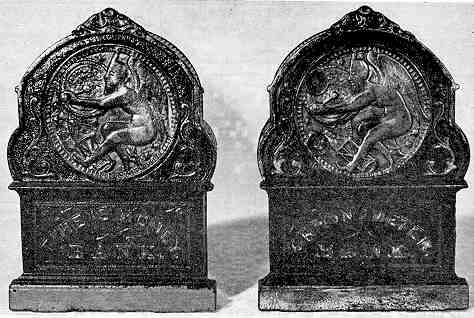The Chronometer Bank
by F.H. Griffith - HOBBIES Magazine - August, 1969

Diverting from mechanicals once again, with specific reasons, we have chosen as our subject matter a rare interesting early registering bank closely related and companion to a very rare mechanical bank. The bank is the Chronometer Bank and it’s right on the heels and crowding for the top position of the Gem Bank, (HOBBIES, September, 1968). Its companion, and they make a great pair, is the Time Is Money Bank (HOBBIES, May, 1959). For the first time, to the best of the writer’s knowledge, they are pictured here together and similarities in appearance they both share are obvious.
The Chronometer is a very early registering type bank and one of the first of its kind. Unfortunately, we have no knowledge of who designed, possibly patented, or manufactured the bank. This also applies to the Time Is Money as both banks were made by the same concern or parties. Both banks are the same size and configuration utilizing the same casting form or shape. It is the writer’s opinion that the Chronometer was manufactured somewhat before the Time Is Money, however, during some period both banks were undoubtedly in production simultaneously.
Fortunately, we are able to supply some factual background concerning the Chronometer thanks to an original old catalog in the writer’s possession. This is the Ehrich’s Fashion Quarterly, Volume II, No. 4, Winter 1876. On page 54 under the heading "Savings Banks" appears a fine picture of the Chronometer Bank. We quote from the text that appears under the picture:
"This Toy Money Bank has a clockwork arrangement by which every penny deposited registers itself so that a child can always know just how much money the bank contains.
"What the bank book and the clerk are to the large depositor, this automatic registering device is to the child, with the additional charm of a little mystery about the way it is done.
"Price, 75c. By mail, 15c extra."
Pictured under and in smaller size than the Chronometer are four early mechanicals, Hall’s Excelsior, Frog On Lattice, Novelty Bank, and Horse Race. Listed, no picture but described, is the Tammany Bank. In any event, with the help of this fine old catalog we know the Chronometer dates in 1876, and possibly earlier.
The Chronometer Bank shown is in fine original condition in all respects including working order and very nice paint. Colors are as follows: The bank is an overall brown lacquer color, the large coin circle with Father Time is silver, and the upper section surrounding the circle is green with gold outlining and decorations. The name Chronometer Bank is gold on a rectangular green background. The bottom base front, completing the coloring, is gold.
The bank at the time of manufacture was made to operate with Indian Head pennies only. As a matter of fact the reverse of an Indian Head penny is depicted on the bank where the lever is held in the hands of Father Time. The penny is inserted in the provided lever and slot located in the top of the bank just to the right of the center peak. The weight of the coin causes the clock-like mechanism to operate. Initially, the upper viewing hole has a large zero and a double zero appears in the lower viewing aperture. The top section goes from 0 to 9 and the lower section from 00 to 90. After 9 pennies are deposited 0 again appears in the upper section on the deposit of the 10th penny. At the same time in the lower section 10 appears. This continues up to 100 pennies when the zero and double zero again appear.
The Chronometer is a very fine desirable early registering bank. It certainly is a great companion to the Time Is Money. The pair of banks in this fashion is unique — one a mechanical and the other a registering, each with totally different mechanism and operation.
